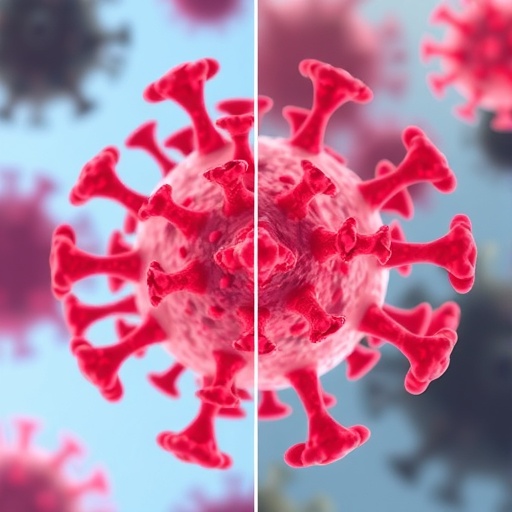In a groundbreaking study published in BMC Cancer, researchers have deployed advanced bioinformatics techniques to unravel the distinctive molecular landscapes separating the two major subtypes of esophageal cancer: esophageal adenocarcinoma (EAC) and esophageal squamous cell carcinoma (ESCC). These subtypes, though originating in the same organ, demonstrate remarkable differences in their biological behavior, epidemiology, and patient prognosis, which necessitate distinct therapeutic strategies.
The investigative team harnessed vast datasets derived from The Cancer Genome Atlas (TCGA) and the Gene Expression Omnibus (GEO) to pinpoint genes whose expression patterns diverged significantly between tumor and normal esophageal tissues. Their refined differential gene expression analysis identified 131 genes uniquely altered in EAC and 49 genes specific to ESCC, highlighting the complex genomic underpinnings that define these cancer subtypes.
To delve deeper into subtype-specific gene networks, the researchers employed Weighted Gene Co-expression Network Analysis (WGCNA). This sophisticated methodology clusters genes into modules based on their correlated expression, enabling the identification of co-regulated gene groups that potentially drive distinct pathological features in EAC and ESCC. Subsequent functional annotation using Gene Ontology (GO) and Kyoto Encyclopedia of Genes and Genomes (KEGG) revealed intricate biological pathways perturbed in each subtype.
Strikingly, ESCC exhibited prominent enrichment of pathways involving the extracellular matrix (ECM), along with those regulating the cell cycle, epithelial‒mesenchymal transition (EMT), and hypoxia signaling. These pathways are critically implicated in tumor invasion, progression, and metastasis, reflecting the aggressive phenotype often associated with ESCC. Conversely, EAC was characterized by alterations predominantly in metabolic pathways, including glycolysis and gluconeogenesis, suggesting a metabolic reprogramming that supports tumor growth under often hypoxic and nutrient-limited microenvironments.
Protein-protein interaction (PPI) network construction further elucidated the hub genes central to each subtype’s pathobiology. These careful molecular dissections revealed potential therapeutic targets that could be exploited to design precision medicine approaches tailored to the unique biology of EAC and ESCC.
The study also ventured into prognostic modeling, establishing risk signatures with significant clinical utility. For EAC, a risk model incorporating six key genes — RHOV, SYTL1, MT1X, PRRG4, KCNK5, and CCL20 — demonstrated robust predictive power for patient outcomes. This model stands to refine patient stratification, guiding clinicians in personalized treatment decisions. In ESCC, the tumor suppressor candidate gene TUSC3 emerged as a vital prognostic biomarker. Its expression was validated in tumor tissue samples, underscoring its potential as a target for novel therapeutic interventions.
Beyond gene expression and prognosis, the researchers explored immune infiltration landscapes, somatic mutation profiles, and copy number variations (CNVs) within the tumors. They discovered distinct immunological microenvironments between EAC and ESCC, which may influence responses to immunotherapy. Similarly, the mutational burden and structural genomic alterations diverged between subtypes, indicating differential mechanisms of tumorigenesis and potential vulnerabilities for targeted therapies.
An intriguing aspect of the investigation addressed drug sensitivity patterns across the two cancer subtypes. By integrating pharmacogenomic data, the team identified differences that could inform clinical decisions, optimizing chemotherapeutic regimens according to the molecular subtype, thereby improving therapeutic efficacy and minimizing adverse effects.
This comprehensive study highlights the power of integrated bioinformatics in oncology research, combining multi-omics data and sophisticated computational frameworks to expose critical molecular distinctions within esophageal cancers. The findings offer a compelling rationale for subtype-specific biomarker development and therapeutic innovation, setting the stage for more effective and individualized treatment paradigms in esophageal cancer management.
The revelation of extracellular matrix and cell cycle perturbations in ESCC contrasts with the metabolic rewiring observed in EAC, painting a nuanced portrait of how two tumors in the same organ evolve through divergent molecular corridors. These insights not only deepen our understanding of esophageal cancer biology but also pave the way for future research exploring how these pathways can be therapeutically targeted.
Furthermore, the integration of immune landscape analyses and genomic instability underscores the importance of considering the tumor microenvironment and genetic context when designing novel treatments. The differential immune infiltrates identifiable between EAC and ESCC could influence strategies involving checkpoint inhibitors or adoptive cell therapies.
With prognostic models now enriched by subtype-specific gene signatures, clinicians are better equipped to predict disease progression and personalize patient care. Validating these signatures in larger, independent cohorts remains a crucial next step, alongside clinical trials to assess the efficacy of targeted therapies informed by these molecular findings.
In summary, this landmark research delineates a comprehensive molecular atlas of EAC and ESCC, emphasizing that esophageal cancer is not a single disease entity but rather a spectrum requiring tailored investigative and therapeutic approaches. As bioinformatics continues to evolve, such integrative studies shine a light on the precise biological mechanisms driving cancer heterogeneity, ultimately translating into improved patient outcomes.
Subject of Research: Molecular distinctions and integrated bioinformatics analysis of esophageal adenocarcinoma (EAC) and esophageal squamous cell carcinoma (ESCC).
Article Title: Integrated bioinformatics analysis of differences between EAC and ESCC.
Article References:
Lyu, Q., Chai, Y., Chen, W. et al. Integrated bioinformatics analysis of differences between EAC and ESCC. BMC Cancer 25, 1668 (2025). https://doi.org/10.1186/s12885-025-15090-z
Image Credits: Scienmag.com




